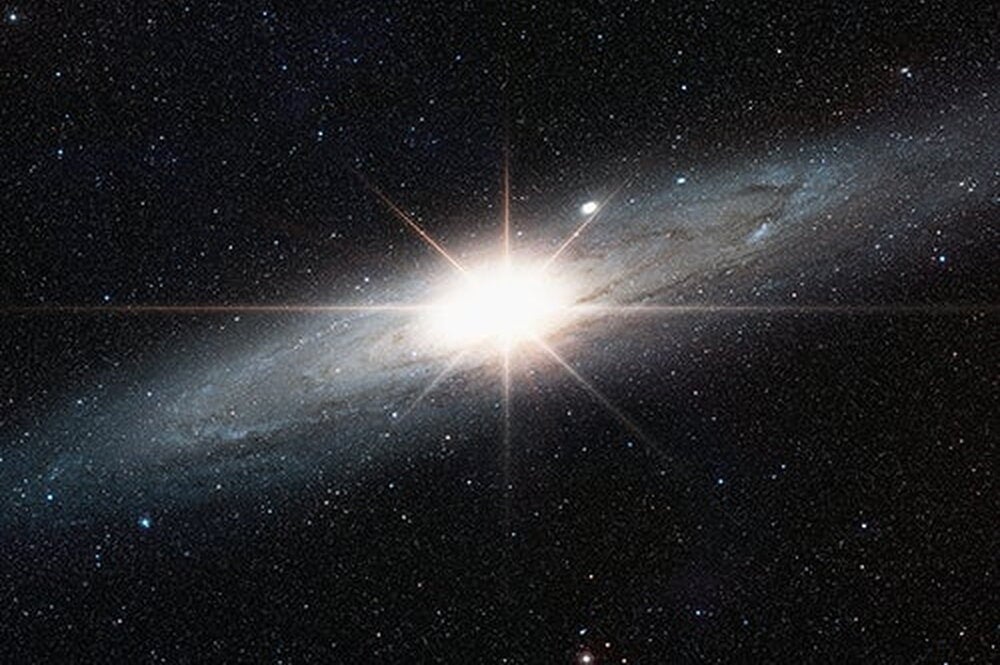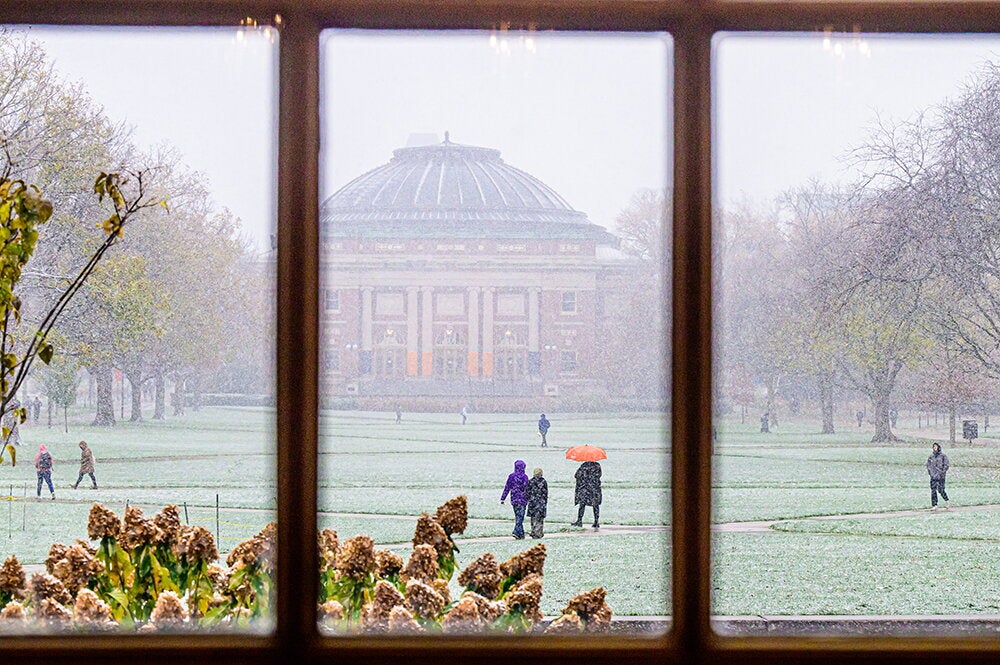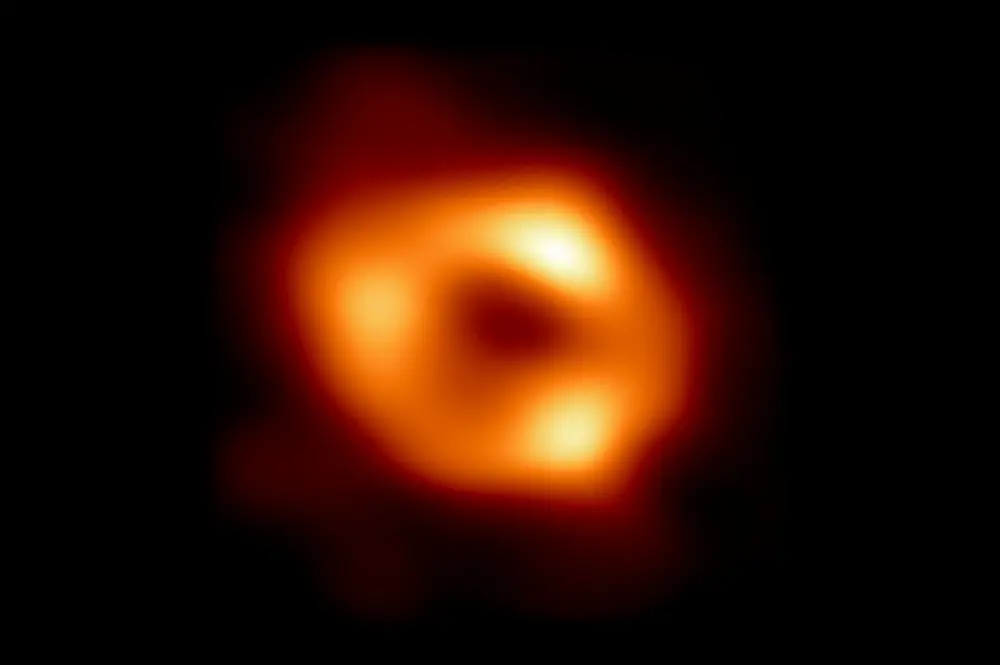
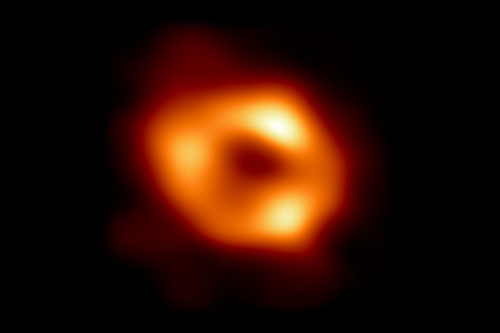
(Image courtesy Event Horizon Telescope collaboration.)
A team of University of Illinois Urbana-Champaign researchers led by physics and astronomy professor Charles Gammie is part of a large international collaboration that unveiled the first image of the supermassive black hole at the center of the Milky Way. This result provides evidence that the object is indeed a black hole and yields valuable clues about the workings of such giants, which researchers think reside at the center of most galaxies.
A global team of researchers involved in the Event Horizon Telescope collaboration produced the image using observations from a worldwide network of radio telescopes. The results are published in six papers included in a special issue of The Astrophysical Journal Letters.
Scientists had previously seen stars orbiting around something invisible, compact and very massive at the center of the Milky Way. This observation strongly suggested that the object – known as Sagittarius A star – is a black hole, and the new image provides the first direct visual evidence.
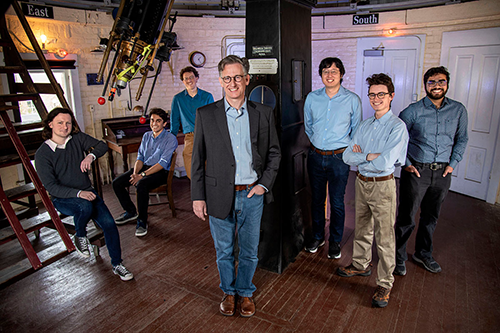
Although we cannot see the black hole, the researchers said glowing gas around it reveals a telltale signature – a dark central region, called a shadow, surrounded by a bright ringlike structure. The new view captures light bent by the powerful gravity of the black hole, which is 4 million times more massive than our sun.
“We were stunned by how well the ring size agreed with predictions from Einstein’s theory of general relativity,” said EHT scientist Geoffrey Bower, of Academia Sinica, Taipei. “These unprecedented observations have greatly improved our understanding of what happens at the very center of our galaxy and offer new insights on how these giant black holes interact with their surroundings.”
Because the black hole is about 27,000 light-years away, it appears to observers on Earth to be about the same size as a doughnut on the moon. To image the black hole, the team created the EHT, which links together eight existing radio observatories across the planet to form a single Earth-sized virtual telescope. The EHT observed Sgr A star on multiple nights, collecting data for many hours in a row, similar to using a long exposure time on a camera.
The new image follows the EHT collaboration’s 2019 release of the first image of a black hole, called M87 star, at the center of the more distant Messier 87 galaxy.
The two black holes look remarkably similar, even though our galaxy’s black hole’s radius and mass are more than a thousand times smaller than those of M87 star. “We have two completely different types of galaxies and two very different black hole masses, but close to the edge of these black holes, they look amazingly similar,” said Sera Markoff, the co-chair of the EHT science council and a professor at the University of Amsterdam. “This tells us that general relativity governs these objects up close, and any differences we see further away must be due to differences in the material that surrounds the black holes.”
This achievement was considerably more difficult than for M87 star, even though Sgr A star is much closer to us. “The gas in the vicinity of the black holes moves at the same speed – nearly as fast as light – around both Sgr A star and M87 star,” said EHT scientist Chi-kwan “CK” Chan, of the University of Arizona. “But where gas takes days to weeks to orbit the larger M87 star, in the much smaller Sgr A star, it completes an orbit in mere minutes. This means the brightness and pattern of the gas around Sgr A star was changing rapidly as the EHT Collaboration was observing it – a bit like trying to take a clear picture of a puppy quickly chasing its tail.”
Watch an animation that shows theoretical models of the black hole at the center of our galaxy.
The researchers said they had to develop new tools that accounted for the gas movement around Sgr A star. While M87 star was an easier, steadier target, with nearly all images looking the same, that was not the case for Sgr A star. The Sgr A star black hole image is an average of the different images the team extracted, finally revealing the giant lurking at the center of our galaxy for the first time.
In addition to developing complex tools to overcome the challenges of imaging Sgr A star, the team worked for five years with supercomputers to combine and analyze its data while compiling a library of simulated black holes to compare with the observations.
“My group and I have spent more than a decade developing key techniques into building models of Sgr A star,” said Gammie, who contributed to the astrophysical modeling portion of the research. “The models do a terrific job of explaining nearly all the data. But we uncovered a mystery – Sgr A star is much quieter than we expected.”
See a video of Gammie and postdoctoral researcher Michi Baubock discussing their team’s contributions to the EHT project.
Scientists said they are particularly excited to finally have images of two black holes of very different sizes, which allows them to understand how they compare. They have also begun to use the new data to test theories and models of how gas behaves around supermassive black holes. The process is not yet fully understood but is thought to play a key role in shaping the formation and evolution of galaxies.
“Now we can study the differences between these two supermassive black holes to gain valuable new clues about how this important process works,” said EHT scientist Keiichi Asada, of Academia Sinica. “We have images for two black holes — one at the large end and one at the small end of supermassive black holes in the universe — so we can go a lot further in testing how gravity behaves in these extremes than ever before.”
Progress on the EHT continues – a major observation campaign in March 2022 included more telescopes than ever before. The ongoing expansion of the EHT network and significant technological upgrades will allow scientists to share more images and movies of black holes.
Editor's note: The paper “First Sagittarius A* Event Horizon Telescope results. V. Testing astrophysical models of the galactic center black hole” in available online and from the News Bureau. DOI: 10.3847/2041-8213/ac6672 This is an abbreviated version of the original news release distributed by the EHT collaboration. The EHT document includes all additional information regarding funders and stakeholders.
